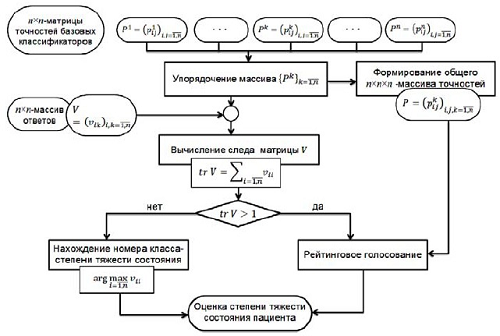Информационная технология оценки степени тяжести состояния пациентов
DOI:
https://doi.org/10.15587/2313-8416.2014.27256Ключові слова:
информационная технология, оценка тяжести состояния пациента, классификация с обучением, композиции (комитеты, ансамбли) классификаторовАнотація
В работе предложена информационная технология оценки степени тяжести состояния пациентов, основанная на разработанных автором методе классификации с обучением и методах построения ансамблей классификаторов. Приведены результаты использования информационной технологии на реальных данных при оценке тяжести состояния 232 пациентов с травматическими повреждениями поджелудочной железы.
Посилання
1. Fleming, W. R., Collier, N. A., Banting, S. W. (1999). Pancreatic trauma: Universities of Melbourne HPB Group. Aust. N. Z. J. Surg., Vol. 69, No. 5, 602–605.
2. Potanina, O. K., Dorfman, A. G., Shvyrev, S. L., Zarubina, T. V., Petrova, M. V. (2011). The experience of using foreign diagnosis nonspecific prognostic models for patients of surgical and oncological profiles. Vestnik RNCRR (Journal (Herald) of RSCRR), 3, 74–85.
3. Tyurin, A. S. (2013). Prediction and assessment of the quality of treatment for patients with fractures of the pelvis with associated trauma, 18.
4. Ivanov, P. A., Grishin, A. V., Korneev, D. A., Zinyakov, S. A. (2003). Injuries of pancrea-duodenal organs. Hirurgiya (Surgery). Juranal imeni N. I. Pirogova, 12, 39–40.
5. Vityuk, T. V., Domans’ky, B. V., Baramiya, N. A. (2002). Surgical treatment of open and closed pancreas injuries. Problemy viyskovoi ohorony zdorov’ya, 11, 387–395.
6. Young, P. R., Meredith, J. W., Baker, C. C. (1998). Pancreatic injuries resulting from penetrating trauma: a multi-institution review. Am. Surg., 64 (9), 838–843.
7. Hannan, E. L., Farrell, L. S., Gorthy, S. F. (1999). Predictors of mortality in adult patients with blunt injuries in New York State: a comparison of the Trauma and Injury Severity Score (TRISS) and the International Classification of Disease, Ninth Revision-based Injury Severity Score (ICISS), 47 (1), 8–14.
8. Yaroshetskiy, A. I. (2006). Integrated assessment of patients’ state and prognosis in a case of severe multi-trauma, 26.
9. Nessonova, M. N. (2014). The method to develop classifiers based on geometrical interpretation of data structure. Actual’ni pytannya pharmacevtychnoi I medychnoi nauky i praktiki, 1 (14), 101–103.
10. Nessonova, M. N. (2013). Metric approach based classifier. Book of abstracts of all-Ukrainians scientific and practical conference of students and young scientists «Actual questions of development of new medicines», 269.
11. Nessonova, M. N. (2013). The rate voting of mixture of experts algorithm in supervised classification problems. Zaporozhskiy medicinskiy zhurnal, 1 (76), 101–102.
12. Nessonova, M. N., Kochina, M. L. (2014). Methods to estimate patient’s grade of severity. Kibernetika i vychislit’l'naya tehnika, 175, 74—87.
13. Djuk, V. A. (2002). Smithereens of knowledge. Express-Electronics, 6, 60–65.
14. Lbov, G. S., Pestunova, T. M. (1985) Grouping objects in heterogeneous featured space (in Non-numerical information analysis in social science), 226.
15. Vorontsov, K. V. (2012). Lecture notes on logical classification algorithms. Available at: http://www.ccas.ru/voron/download/LogicAlgs.pdf.
16. Aivazyan, S. A., Buchstaber, V. M., Yenyukov, I. S., Meshalkin, L. D. (1989). Applied statistics: Classification and reduction of dimensionality: Reference Edition. Moscow: Financy i statistika, 607.
17. Kuncheva, L. I. (2004). Combining pattern classifiers: methods and algorithms. Hoboken, New Jersey: A Wiley- Interscience publication, 360.
18. Osborne, M. L. (1977). The seniority logic: A logic for a committee machine. IEEE Trans. on Comp., Vol. C-26, No. 12, 1302–1306.
19. Congalton, R. G. (1991). A review of assessing the accuracy of classifications of remotely sensed data. Remote Sens. Environ., 37, 35–46.
20. Nessonova, M. N., Kochina, M. L. (2013). Applying results of the information technology for grade of severity estimation and clinical outcome prediction in a case of pancreas trauma. Clinical Informatics and Telemedicine, 10 (9), 102–107.

##submission.downloads##
Опубліковано
Номер
Розділ
Ліцензія
Авторське право (c) 2014 Марина Николаевна Нессонова

Ця робота ліцензується відповідно до Creative Commons Attribution 4.0 International License.
Наше видання використовує положення про авторські права Creative Commons CC BY для журналів відкритого доступу.
Автори, які публікуються у цьому журналі, погоджуються з наступними умовами:
1. Автори залишають за собою право на авторство своєї роботи та передають журналу право першої публікації цієї роботи на умовах ліцензії Creative Commons CC BY, котра дозволяє іншим особам вільно розповсюджувати опубліковану роботу з обов'язковим посиланням на авторів оригінальної роботи та першу публікацію роботи у цьому журналі.
2. Автори мають право укладати самостійні додаткові угоди щодо неексклюзивного розповсюдження роботи у тому вигляді, в якому вона була опублікована цим журналом (наприклад, розміщувати роботу в електронному сховищі установи або публікувати у складі монографії), за умови збереження посилання на першу публікацію роботи у цьому журналі.
